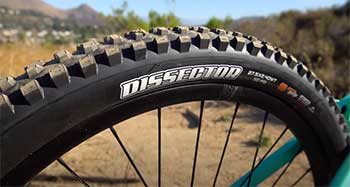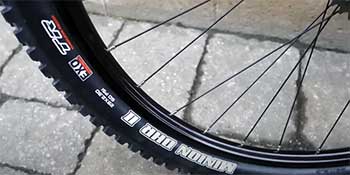Mountain biking enthusiasts are often found debating the supremacy of one tire over the other. Today, we’re getting into the thick of such a debate – Maxxis Dissector vs. DHR2 tires.
This head-to-head will aim to reveal which product takes the crown, while also answering a few frequently asked questions about these two stalwarts.
A Brief Comparison Table
| Features | Maxxis Dissector | Maxxis DHR2 |
| Primary Use | Downhill Riding | Versatile (Climbing, Descending, Loose to Wet Terrain) |
| Tread Pattern | Semi-slick center tread, high-volume side knobs | Ramped and siped center knobs, aggressive side knobs |
| Terrain Preference | Dry, loose | Wide variety (dry, loose, muddy, rocky) |
| Wet Conditions Performance | Not Ideal | Good (though might clog in very muddy conditions) |
| Climbing Performance | Not Ideal | Excellent |
| Rolling Resistance & Speed | Lower resistance, higher speed | Slightly higher resistance, may be slower than Dissector |
Introduction To Maxxis Dissector

Crafted under the supervision of Australian downhill sensation Troy Brosnan, the Maxxis Dissector aims to be the ultimate tire for fast and aggressive downhill riding.
It’s a weapon of choice for dry, fast, and loose terrains, where its tread pattern offers superb cornering grip and speed.
Pros of Maxxis Dissector
- High-Speed Cornering: The Dissector’s side knobs ensure optimal cornering grip at high speeds, making it a downhill rider’s dream.
- Fast and Loose Terrain Performance: With its unique tread pattern, the Dissector shines in dry, loose terrain, making it a fantastic choice for summer riding.
- Reduced Rolling Resistance: Thanks to its center tread design, the Dissector offers lower rolling resistance, translating to increased speed.
Cons of Maxxis Dissector
- Wet Weather Performance: The Dissector’s performance can dip in wet, muddy conditions. Its focus on dry and loose terrains means it might not be the ideal all-rounder for every trail.
- Not the Best for Climbing: The same design features that make it excellent for downhill runs might impede its performance during steep climbs.
Introduction To Maxxis DHR2
Next in the ring is the Maxxis DHR2, a direct descendant of the famed DHF tire. This tire offers a great mix of rolling resistance and grip. It boasts ramped and siped tread to reduce rolling resistance, yet maintain braking traction.
Pros of Maxxis DHR2

- Excellent Braking: With its large surface area and well-spaced knobs, the DHR2 provides impressive braking power, even in loose conditions.
- Versatile Performance: The DHR2 is designed to perform well across a variety of conditions, making it an ideal choice for riders traversing varying terrain.
- Top-Notch Climbing Abilities: The aggressive tread design provides solid grip, making the DHR2 a reliable companion for challenging climbs.
Cons of Maxxis DHR2
- Potential for Mud Clogging: Although it can handle various conditions, the DHR2’s closely spaced knobs can clog with mud in really wet conditions.
- Slightly Higher Rolling Resistance: While the DHR2 provides excellent grip, this comes with a slightly higher rolling resistance, reducing its speed compared to the Dissector.
Also Read: Is Prinx HiCountry HT2 Tire Worth It?
Key Differences between Maxxis Dissector and DHR2 Tires
When choosing between the Maxxis Dissector and DHR2 tires, the devil is in the details. Though they might appear similar at first glance, a deeper analysis reveals unique features that separate these two contenders.
Let’s explore these differences in depth to provide a comprehensive guide to assist you in your buying decision.
- Tread Pattern
The Maxxis Dissector boasts a unique tread pattern specifically designed for dry, fast, and loose terrains. Its signature design includes a semi-slick center tread for decreased rolling resistance, allowing you to cruise at high speeds.
Meanwhile, the tire’s high-volume and robust side knobs provide excellent cornering control, especially during downhill rides.
In contrast, the DHR2 features a more aggressive, versatile tread pattern designed to handle a wider variety of terrains. The tire’s ramped and siped center knobs reduce rolling resistance while simultaneously improving braking traction.
Its side knobs, borrowed from the popular DHF model, offer reliable grip during sharp turns.
- Versatility
While the Dissector specializes in dry, loose terrains, the DHR2 shines in its versatility. Thanks to its adaptable tread design, the DHR2 can confidently traverse a variety of terrains, from dry, loose conditions to muddy, rocky trails.
Thus, if your biking escapades take you across diverse terrains, the DHR2 might be your best bet.
- Performance in Wet Conditions
The DHR2’s versatility extends to its performance in wet conditions. While the Dissector struggles in wet and muddy conditions, the DHR2 handles these scenarios relatively well.
However, in particularly muddy conditions, the DHR2’s knobs might get clogged, somewhat hampering performance.
- Climbing Abilities
The Dissector, with its primary focus on downhill speed and control, might not be the ideal choice for steep climbs. On the other hand, the DHR2, thanks to its aggressive tread design, excels at climbing.
Its ample knob spacing and larger surface area provide robust grip, making the DHR2 a reliable companion for uphill challenges.
- Rolling Resistance and Speed
In terms of rolling resistance, the Dissector generally comes out ahead. Its semi-slick center tread is designed to reduce rolling resistance, resulting in increased speed, particularly on downhill runs.
On the other hand, the DHR2, while it does have ramped center knobs for reduced resistance, might not be as fast as the Dissector due to its more aggressive, traction-focused tread pattern.
Also Read: Differences Between DHF And Assegai Tires.
Frequently Asked Questions (FAQ)
The Maxxis Dissector is designed for fast and aggressive downhill riding, particularly excelling in dry, loose conditions.
While the DH34 and DHR2 are both quality Maxxis products, their primary difference lies in their purpose. The DH34 is specifically designed for downhill riding, with a focus on durability and control, while the DHR2 offers versatile performance across various terrains, with an emphasis on grip and braking traction.
The Maxxis Minion DHF and DHR tires have different specialties. The DHF is renowned for its cornering grip, while the DHR has a reputation for its impressive braking traction. However, in terms of rolling speed, the DHF tends to have slightly lower rolling resistance, making it faster in straight runs.
The acronym ‘DHR’ in Maxxis Minion DHR stands for ‘Down Hill Rear.’ This is indicative of the tire’s initial design intent – to be a superior rear tire for downhill applications.
Conclusion
Choosing between the Maxxis Dissector and the DHR2 isn’t a clear-cut decision; it ultimately boils down to your specific riding preferences and trail conditions. If your heart beats faster for aggressive, speedy downhill rides on loose terrain, the Dissector is your tire.
But if versatility, braking power, and climbing abilities are more crucial to your biking escapades, the DHR2 will be your go-to companion.
In the world of mountain biking, understanding your equipment is as important as knowing the trail. We hope this comprehensive comparison has given you a clear insight into the world of Maxxis Dissector and DHR2 tires, aiding your decision-making process for your next thrilling ride.
Remember, in the end, the best tire is the one that makes you feel confident, safe, and ready to take on any trail.

